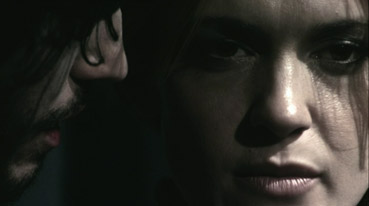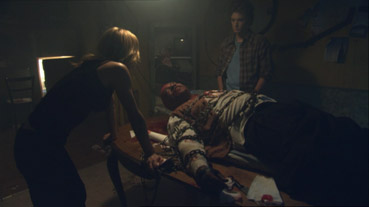|
If you've seen as many vampire movies as I have then you might find yourself asking the same question every time you hear of a new one: is there really any mileage left in the genre? It's not a question of its longevity – we're only a few years off from its centenary now – but the fact that the most revolutionary and revisionist period of its development came and went some years ago with films like George Romero's Martin, Catherine Bigelow's Near Dark and Abel Ferrara's The Addiction.
The recent revival of interest in the genre has led to some interesting but hardly groundbreaking works. A couple of friends (and indeed one of our own reviewers) was particularly enthusiastic about David Slade's 30 Days of Night, but I was less taken by a work that I thought was visually attractive but constructed around well worn character arcs (Joseph Campbell's Hero, Princess and Helper are clearly identified in the first few minutes). I still liked it more than another friend of mine, who rather cruelly retitled it "113 Minutes of Bollocks."

Indie vampire movies tend to be more interesting than their mainstream brethren, partly because of the freedom their makers have to explore the very concept of vampirism from a new or unconventional angle. At least that's the theory. It's not often they do, of course, and the spectre of those earlier mentioned movies of years past – Martin in particular – offers a considerable challenge for any would-be vampire revisionist, one that few filmmakers appear ready or equipped to rise to. We vampire movie fans have thus come to expect no more than small variations on familiar themes. Other than that, it's all in the characters and execution. But get this right and you've still got a potentially worthwhile genre piece on your hands.
Brotherhood of Blood certainly has few recognisable touchstones, but it also acknowledges audience familiarity with the genre's codes and conventions and thus wastes no time on the traditional preamble, kicking off what what is effectively a build-up to the climactic scene. Well-dressed Tom (William Snow) is tied to a chair and taking a beating, while handcuffed and agitated doctor Carrie (Victoria Pratt) looks on and secretly attempts to free herself. The aggressors are vampires and they're looking for Tom's vampire brother and will do whatever is needed to get that information, and if that means taking a blowtorch to their captive's flesh then so be it. Tom tries to convince them that Carrie has been working on a cure for their condition, but they know something he doesn't – Carrie's actually not a doctor at all, but a vampire hunter, and she's just using Tom to get to his brother and kill him.
It's an intriguing and breezy start in which plot and character information are introduced but deliberately not clarified at this early stage. As head interrogator Fork (Wes Ramsey) nips off to consult with brood leader Pashek (Rob Zombie regular Sid Haig), Carrie gets free and stakes the two guards, and then barricades herself and Tom in the room. "Who are you?" the battered and bemused Tom wants to know. Bloody good question.
It's here that the film's second hook sinks in and the story hops back a day to the pair's first meeting, the first step in a non-linear approach that allows key facts to be revealed when the narrative demands it rather then when they become evident to the characters. One thing established early on is that these vampires are superstitious creatures whose greatest fear is of a demonic über-vampire they call Vlad Kossel, whom they suspect is back from the dead and has taken on humanoid form. It's also quickly confirmed that Carrie is no lone vampire hunter but part of an organised group, a sort of rough-and-ready (and frankly more realistic) version of the team at the centre of John Carpenter's Vampires.

To say to much about the group's quest and actions would mean revealing plot points that the story structure has been designed to keep initially concealed. Functioning like a beleaguered guerrilla army in an incendiary war zone, the team use the meagre spoils of their kills to fund their equipment and obtain information through a combination of investigation and conscience-free torture, chaining black vampire Stanis (the always enjoyable Ken Foree) to a table, pulling his teeth, severing a finger and clearly quite prepared to do far worse if he won't talk.
The influences are easy to spot, from the Blade 2-esque super-vampire who is equally threatening to humans and vampires alike to vampire hunters whose pragmatic resourcefulness echoes the holed-up survivors of Romero's Dawn of the Dead (which Ken Foree starred in), and there's almost a sense at times that the film putting itself forward as a down-and-dirty Buffy replacement. What sells it, and it does sell, is the gritty, gimmick-free handling and the urgent sincerity of the performances – the vampire hunters in particular come across as completely committed to their cause, their no-nonsense approach to combat and torture having the authentic ring of actions shaped by experience rather than rehearsal. Even the team's too-obvious weak link, the unlikely and constantly horrified young wannabe vampire hunter Derek, manages at least one surprising deviation from his expected character arc.
Unsurprisingly, Brotherhood of Blood breaks no new genre ground, but after a few years of the glossy visual trickery of effects-laded studio vampire flicks, its grubby aesthetic and claustrophobic energy are like a small breath of fresh indie air. Some of the plot logic is open to hole picking and there's a nagging sense that there's a lot less substance here than the structural fragmentation suggests, but this is still a neat little entry into a genre that, despite having passed its creative peak, is clearly not yet ready to die.
Shot on a Sony CineAlta HDC-F950 hi-def camcorder (aren't you glad I told you that?), the image quality is a little variable, the solid contrast of the brighter sequences giving way to a more washed-out look in the darker scenes. Whether this was intentional is uncertain, but the loss of blacks to blue or grey when you really need that dark room to be DARK does take the edge off the tension at times. Upscaling to HD on my system really exaggerated this. Detail is good on the better contrast close-ups, but the slightly softer image elsewhere actually sits rather well with the low budget aesthetic. The transfer is 16:9 anamorphic.
Stereo 2.0 and 5.1 tracks are on offer – the 5.1 is a more subtle, widely spread mix, but the dialogue fights a little with the music and sound effects in places, which is not a problem with the louder stereo track. Separation is reasonable on both tracks, but nothing flashy.
Trailer (1:19)
An OK, briskly edited sell.
Behind the Scenes (5:10)
A not too illuminating EPK with a few brief cast interviews and a smidgen of on-set footage.
Nothing revolutionary but pretty damned good all the same. I liked Carrie's team enough to wish they figured more prominently in the film, especially as their international make-up suggests a back-story that itself might be interesting to explore. Victoria Pratt engages as the Sarah Connor-style heroine, not least in the tough physicality of her performance, and the film takes its vampires as seriously as the actors treat their roles. I'm not completely sold on the transfer, but vampire movie fans should definitely check this one out.
|